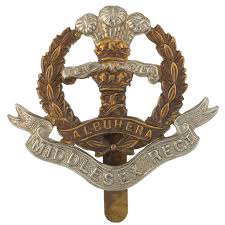Personal Details
Born: In 1897 in Tushingham, Cheshire and known as Samuel.
Family: He was the fifth of six children born to William Mellor, a farm labourer, and his wife Annie. No marriage can be traced for Samuel.
Residence: In 1901 he lived at Willey Moor, Tushingham, Cheshire; in 1911 he was boarding at 5 Scotland Street with his father (now a widower) and brother Henry. This is the address shown on the 1919 Absent Voters’ register and his army pension card. When he died he was in the Salop Mental Hospital, Shelton, Shrewsbury.
Employment: Not known
Died: In 1938 at the Salop Mental Hospital and was buried on 6 December the same year in Whitchurch cemetery.
Military Details
Regiment: Middlesex Regiment (previously King’s Shropshire Light Infantry)
Rank: Private
Service Number: G/106715 (previously 24453)
Date of Enlistment: Not known
Date of Discharge: 12 December 1919
Reason for Discharge: Not known
Other Information: He was the brother of John Thomas Mellor and William Mellor who both died in WW1 and are commemorated on the Whitchurch Town memorial.
Samuel was awarded the Campaign Medals (British War Medal, and Victory Medal).

The British War Medal (also known as 'Squeak') was a silver or bronze medal awarded to officers and men of the British and Imperial Forces who either entered a theatre of war or entered service overseas between 5th August 1914 and 11th November 1918 inclusive. This was later extended to services in Russia, Siberia and some other areas in 1919 and 1920. Approximately 6.5 million British War Medals were issued. Approximately 6.4 million of these were the silver versions of this medal. Around 110,000 of a bronze version were issued mainly to Chinese, Maltese and Indian Labour Corps. The front (obv or obverse) of the medal depicts the head of George V. The recipient's service number, rank, name and unit was impressed on the rim.
The Allied Victory Medal (also known as 'Wilfred') was issued by each of the allies. It was decided that each of the allies should each issue their own bronze victory medal with a similar design, similar equivalent wording and identical ribbon. The British medal was designed by W. McMillan. The front depicts a winged classical figure representing victory. Approximately 5.7 million victory medals were issued. Interestingly, eligibility for this medal was more restrictive and not everyone who received the British War Medal ('Squeak') also received the Victory Medal ('Wilfred'). However, in general, all recipients of 'Wilfred' also received 'Squeak' and all recipients of The 1914 Star or The 1914/1915 Star (also known as 'Pip') also received both 'Squeak' and 'Wilfred'. The recipient's service number, rank, name and unit was impressed on the rim.

